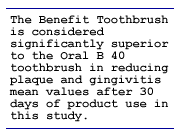|
The Benefit toothbrush completed a 30-day evaluation for clinical safety and efficacy that was conducted by Samuel L Yankell, Ph.D., R.D.H.. Research Professor in Periodontics for the School of Dental Medicine at the University of Pennsylvania in Philadelphia, Pennsylvania and Robert C. Emling, EdD. Director of Development for International Dental Research, Ltd. in Moorestown, New Jersey. This clinical study was designed to compare the Benefit toothbrush
with Oral B Laboratories Oral B 40 manual toothbrush and Bausch
& Lomb’s lnterplak electric-powered toothbrush in plaque
and gingivitis evaluations. Plaque area was scored using the method of Turesky, et al, with the Plak-lite disclosing system. Gingivitis was evaluated using the method of Loe and Silness, at the buccal and lingual gingival margins of the Ramfjord teeth. If a Ramfjord tooth was missing the adjacent tooth with the same morphology was used for assessment. Bleeding on probing was performed according to the Eastman Dental Center published method on medial and distal interproximal areas of the premolar and molar teeth contralateral to the Ramfjord teeth. Excerpts from the final report dated April 22, 1992. from this study are reproduced below. Summary and Conclusions: “This study was performed in compliance with the American Dental Association guidelines to compare efficacy and safety of three toothbrush products; Oral B, an ADA accepted manual toothbrush Interplak, an ADA accepted powered toothbrush and the Benefit experimental manual toothbrush. Safety, plaque, gingivitis and bleeding on probing were evaluated at Baseline, Days 15 and 30. No oral irritation was observed or reported, related to toothbrush use, throughout the study or at any examination time. Plaque area indices were not different among the three brush groups when patients reported for baseline assessment the first day, day I5 and day 30. After using their assigned product, the Benefit brush was significantly more effective than the Oral B product on lingual and total plaque reduction from tooth brushing from baseline date to day 15 and day 30. The Interplak product was also superior to the Oral B toothbrush on total plaque removal at all assessment periods, and in removing lingual plaque at day 15 and buccal plaque on day 30. There was no significant difference in plaque removal between the Benefit toothbrush and the Interplak unit at anytime during the study. Gingivitis indices were significantly lower in the group compared to the Interplak and Oral B group means. At day 30 the Benefit gingivitis scores were significantly lower than Oral B mean values. There were no significant differences in bleeding on probing among the three groups at any time in the study. The Benefit Toothbrush is considered significantly superior to the Oral B 40 toothbrush in reducing plaque and gingivitis mean values after 30 days of product use in this study. There were no significant differences between the Benefit toothbrush and the Interplak product on plaque removal, gingivitis or bleeding upon probing during this thirty-day study.” Technological University of Mexico The toothbrush completed an additional six-week study by the Technological
University of Mexico "Pablo Funtanet" Dental Care Center
by Dr. Ana Marfa Hernandez Santamarfa, a prophylactic dentist and
periodontist with studies in Periodontology and Anatomy-Physiology
(Buccal Biology) at the Universite de Paris. The conclusions reached from this study can be summarized as follows: “even though the patients in this study normally use the "Stillman" or "Modified Stillman” techniques when brushing their teeth. The design of the Benefit toothbrush caused these patients to switch to the “Bass” technique with excellent results. The presence of dentobacterial plaque decreased substantially by using the Benefit toothbrush. On rotated or unpositioned teeth, a minimal but present dentobacterial plaque was observed in the study. Periodontal irritation, which is typically present with any new toothbrush or initially upon changing brushing techniques (from Stillman to Bass) was present with the Benefit toothbrush at the start of the study. However, gingival inflammation decreased considerably from the second up to the fourth week of the study. Furthermore, this study recommended that the bristles that contact the gums and sulcular area be changed to a softer gauge or that different variants of the toothbrush be developed(1). The overall result of the study recommended the use of the Benefit toothbrush due to the product’s success in eliminating dentobacterial plaque from the surfaces of the teeth.” 1) Subsequent to the testing of this early prototype of the Benefit toothbrush “soft bristles” and “medium bristles” variants that incorporate softer bristles on the gum line row of tufts of the side brush-heads have been developed. American Dental Association The Benefit toothbrush has received an accepted rating from the American Dental Association, (“ADA”).
|
[ Top ]

2055 North Airway Dr, Baton Rouge, LA 20815
Voice: 410-263-5151 || Fax: 225-927-8135 || info@benedent.com
website design by kirkor consulting + design, llc || www.kirkor.com
 Ninety-six
subjects, composed of thirty-two subjects in each of three groups,
were tested over a period of 30 days, with measurements taken at
Day 0 (“Baseline”), Day 15 and Day 30.
Ninety-six
subjects, composed of thirty-two subjects in each of three groups,
were tested over a period of 30 days, with measurements taken at
Day 0 (“Baseline”), Day 15 and Day 30. The
objective of the study was to determine the efficacy of the toothbrush
for the removal of bacterial plaque and food residues, as well as
to determine whether it can provide adequate massaging of the gingiva
and stimulation of blood circulation without causing adverse conditions
to the soft oral tissues.
The
objective of the study was to determine the efficacy of the toothbrush
for the removal of bacterial plaque and food residues, as well as
to determine whether it can provide adequate massaging of the gingiva
and stimulation of blood circulation without causing adverse conditions
to the soft oral tissues.